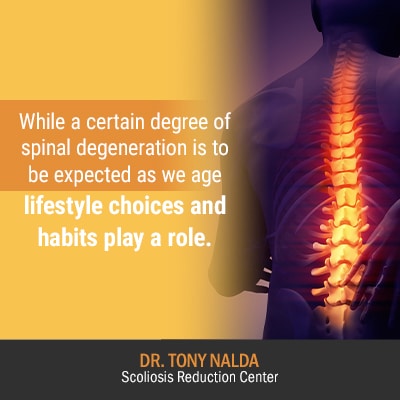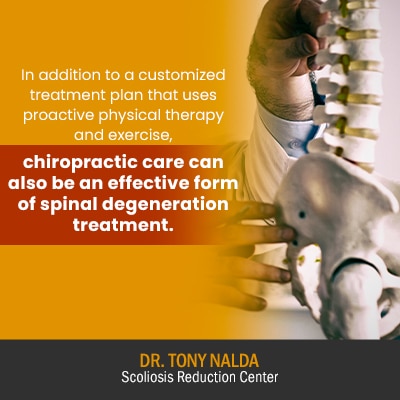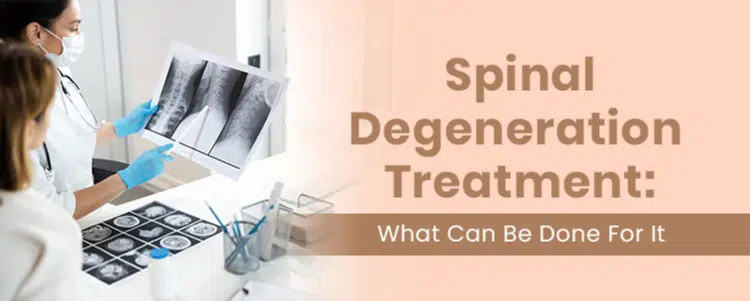There are different levels of spinal degeneration and many reasons why it can happen. The main cause is natural age-related deterioration, but there are also a number of lifestyle choices and spinal conditions that can speed up the degenerative process, not to mention spinal trauma and injury.
When it comes to spinal degeneration treatment, the underlying cause guides the approach. Preventing further deterioration is key for natural age-related spinal degeneration; lifestyle changes can be part of that. If a spinal condition or injury is the cause, it needs to be treated proactively.
As there are different causes of spinal degeneration, let’s start with the most common: natural age-related changes.
The Aging Spine
The spine is made up of bones (vertebrae) and intervertebral discs. In a healthy spine, the vertebrae are rectangular in shape and stacked on top of one another in a straight and neutral alignment.
The spine is naturally curved at each of its main sections (cervical, thoracic, and lumbar) because it makes the spine stronger, more flexible, and better able to evenly absorb/distribute mechanical stress.
In general, the spine’s intervertebral discs are the first spinal structures to face degenerative changes, and they also help the spine maintain its natural and healthy curvatures and alignment.
Intervertebral Discs
The intervertebral discs sit between adjacent vertebrae. They have two main parts: a tough, durable outer layer (annulus fibrosus) and a soft gel-like interior (nucleus pulposus).
The discs perform many roles that are essential for preserving overall spinal health and function; they provide cushioning between vertebrae, give the spine structure, and act as its shock absorbers.
When we’re born, the intervertebral discs are made up of 80-percent water, but as we age, that hydration-level changes, and when a disc starts to dry out, either due to lifestyle habits, aging, or a spinal condition, disc desiccation can cause the disc to lose height, which affects the positioning of adjacent vertebrae, and is a common indicator of degenerative disc disease (DDD).
Without the cushioning of the intervertebral discs, the nerve roots and/or spinal cord can get exposed to uneven pressure and become pinched. The spine’s ability to maintain its natural and healthy curvatures is compromised when this happens.
When there is a degree of nerve involvement, a wide range of spinal degeneration symptoms can develop from localized and/or radicular pain felt in the back, arms, and legs to feelings of numbness and/or tingling in affected areas.
So now that we’ve talked about the spine’s intervertebral discs and how they are the most vulnerable to spinal degeneration let’s talk about causation and the different factors that can lead to spinal degeneration.
Spinal Degeneration Causes
There are different reasons why the spine faces degenerative changes, but the most common, as mentioned, is age.
Women are also more prone to spinal degeneration as they age due to changes in hormone levels and bone density related to menopause.
In addition, as some people age, they become less active and lose muscle. The spine’s very design is based on movement, so once activity levels start to decrease, it can impact the spine in numerous ways.
Particularly when it comes to the intervertebral discs, which don’t have their own vascular supply, staying hydrated is essential, and it’s only through movement and increased circulation in the areas surrounding the discs that they can absorb important nutrients and rejuvenate themselves.
Most adults over the age of 40 will start to experience varying degrees of spinal degeneration. This can be a natural part of aging, but not everyone reaches a certain level of spinal degeneration; this is where lifestyle choices can come into play.
Lifestyle Choices

While a certain degree of spinal degeneration is to be expected as we age, lifestyle choices and habits play a role.
If a person is engaging in negative lifestyle habits that impact the spine, combined with natural age-related degenerative changes, the cumulative effect can be an unhealthy spine over time.
Carrying excess weight, smoking, leading a sedentary lifestyle, chronic poor posture, and/or repeatedly lifting heavy objects incorrectly can expose the spine to uneven wear, strain and speed up spinal degeneration.
Remember, as the intervertebral discs don’t have their own vascular supply, once they are damaged, it’s difficult to fully reverse that damage, and in many cases, the treatment focus is on preventing further damage through proactive lifestyle changes.
While lifestyle and age are the most common causes of spinal degeneration, additional causes would include the presence of spinal conditions, medical issues, and/or trauma experienced by the spine.
Spinal Conditions
There are a number of spinal conditions that can impact the overall health and function of the spine.
Conditions like scoliosis, lordosis, and kyphosis that involve the development of unhealthy spinal curves can speed up spinal degeneration because they disrupt the biomechanics of the spine and expose it to uneven pressure and wear.
Conditions like osteoarthritis and osteoporosis involve the loss of cartilage and the related rubbing together of joints, and weaker bones, making them more prone to injury.
Additional medical issues that can impact the health of the spine are the presence of spinal tumors and infection.
Tumors that press on the spine can expose the affected area to uneven pressure and force it out of alignment, which means the discs are also exposed to uneven pressure, which can speed up spinal degeneration.
Low-grade infection has also been linked to the presence of degenerative disc disease (DDD).
In addition, if a bad fall or accident has caused a spinal fracture, this can also weaken the spine and speed up spinal degeneration.
So as you can see, there are different causative sources for spinal degeneration, from natural age-related changes to negative lifestyle choices, degenerative spinal conditions, infection, and injury.
There are different forms of treatment guided by various causative sources when it comes to answering what can be done for spinal degeneration.
Spinal Degeneration Treatment
When it comes to options of treating spinal degeneration, there are different forms of treatment available: some that focus solely on addressing the symptoms of spinal degeneration, and some that focus on positively impacting the condition by addressing its underlying cause.
Here at the Scoliosis Reduction Center®, I believe in a proactive chiropractic-centered treatment approach that combines multiple forms of treatment for the best results.
In order for treatment to be effective, it has to address the condition’s underlying cause as there is a big difference between treating symptoms of a condition and the condition itself.
For example, the most common treatment for spinal degeneration is medication.
Medication as Treatment for Spinal Degeneration
While some anti-inflammatory medications and steroid injections can reduce inflammation of affected areas, thereby reducing the pressure on nearby nerves, their focus is on pain management.
While some levels of spinal degeneration don’t produce noticeable symptoms, as progression occurs, particularly over time and with age, symptoms like pain and/or mobility issues tend to increase.
While pain management is important, being proactive means also addressing the underlying cause of the pain.
For example, when treating an older adult with degenerative scoliosis, while pain management can be one facet of treatment, the larger focus is on how best to impact the condition structurally, as scoliosis is a structural condition.
While there are never treatment guarantees, as improvements are worked towards that change the structure of the spine, related symptoms are also impacted positively, and these are the types of treatment results that are sustainable; medication often has to be increased over time to have the same effect, and if medication is the sole form of treatment, the short-term pain relief provided is not sustainable.
Here at the Center, patients benefit from different forms of treatment that work together to impact the condition on multiple levels and don’t just focus on addressing one aspect of spinal degeneration.
Physical therapy and condition-specific exercises are an important part of my integrative approach.
Physical Therapy and Exercise as Treatment for Spinal Degeneration
Crafting an effective treatment plan for spinal degeneration involves a combination of regular exercise and physical therapy; that being said, no exercise regime should ever be adopted without consulting a professional for guidance.
The very design of the spine is based on movement, which is why leading a sedentary lifestyle can be so damaging.
Spinal movement/exercise is important for pain management, disc replenishment, and muscle, ligament, and joint strength.
It’s not just the spine itself and its intervertebral discs that support and stabilize it, but also its surrounding muscles and ligaments.
Increasing core strength through condition-specific physical therapy can mean the spine is optimally supported and stabilized, taking some pressure off the spine, its discs, and surrounding nerves.
Stronger spinal muscles and exercise also increase circulation. As the intervertebral discs don’t have their own vascular supply, meaning no direct path for blood (nutrients and oxygen) to enter and leave the discs, they absorb important nutrients needed for cellular repair through a process of osmosis.
If an X-ray and physical exam tell me that disc degeneration is present in one or more discs, I can focus specific stretches and exercises on the affected area as the increased circulation around the affected discs can help them absorb nutrients needed for rejuvenation, cellular repair, improve function, and help prevent further degeneration.

In addition to a customized treatment plan that uses proactive physical therapy and exercise, chiropractic care can also be an effective form of spinal degeneration treatment.
Chiropractic Care
Many different chiropractic techniques can work towards improving the health of the spine and its discs: the following are a few of the most common.
Precise and gentle spinal manipulation can help isolate the joints that are restricted, increase their range of motion, and improve the health of affected discs.
Flexion-distraction is another technique that uses a specialized type of table to precisely manipulate the spine while ‘distracted’ by gentle movement. I often use this type of technique to address herniated discs and/or spinal stenosis.
I can also perform instrument-assisted manipulation with a hand-held instrument to apply gentle force without pressing directly into the spine.
When it comes to spinal degeneration treatment, I focus on two main things: improving the health and function of the spine and its discs and preventing as much further degeneration as possible.
Conclusion
At some point in life, everyone will experience a degree of spinal degeneration as they age, but that doesn’t mean that proactive steps can’t be taken to preserve spinal health and function and prevent degenerative changes for as long as possible.
While aging is the most common cause of spinal degeneration, especially in older women, lifestyle factors, other spinal conditions, and injury are additional causative sources.
Here at the Scoliosis Reduction Center®, I apply an integrative chiropractic-centered treatment approach to address spinal degeneration.
By crafting a comprehensive and customized treatment plan, I can work towards achieving specific results that address symptoms of spinal degeneration and its underlying cause.
Whether the spine is deteriorating because of age, lifestyle, another spinal condition, or injury, my first step towards proactive treatment is through diagnosis and assessment.
Once I determine the underlying cause of the spinal degeneration, I design a treatment plan that proactively addresses that cause and any related symptoms.





